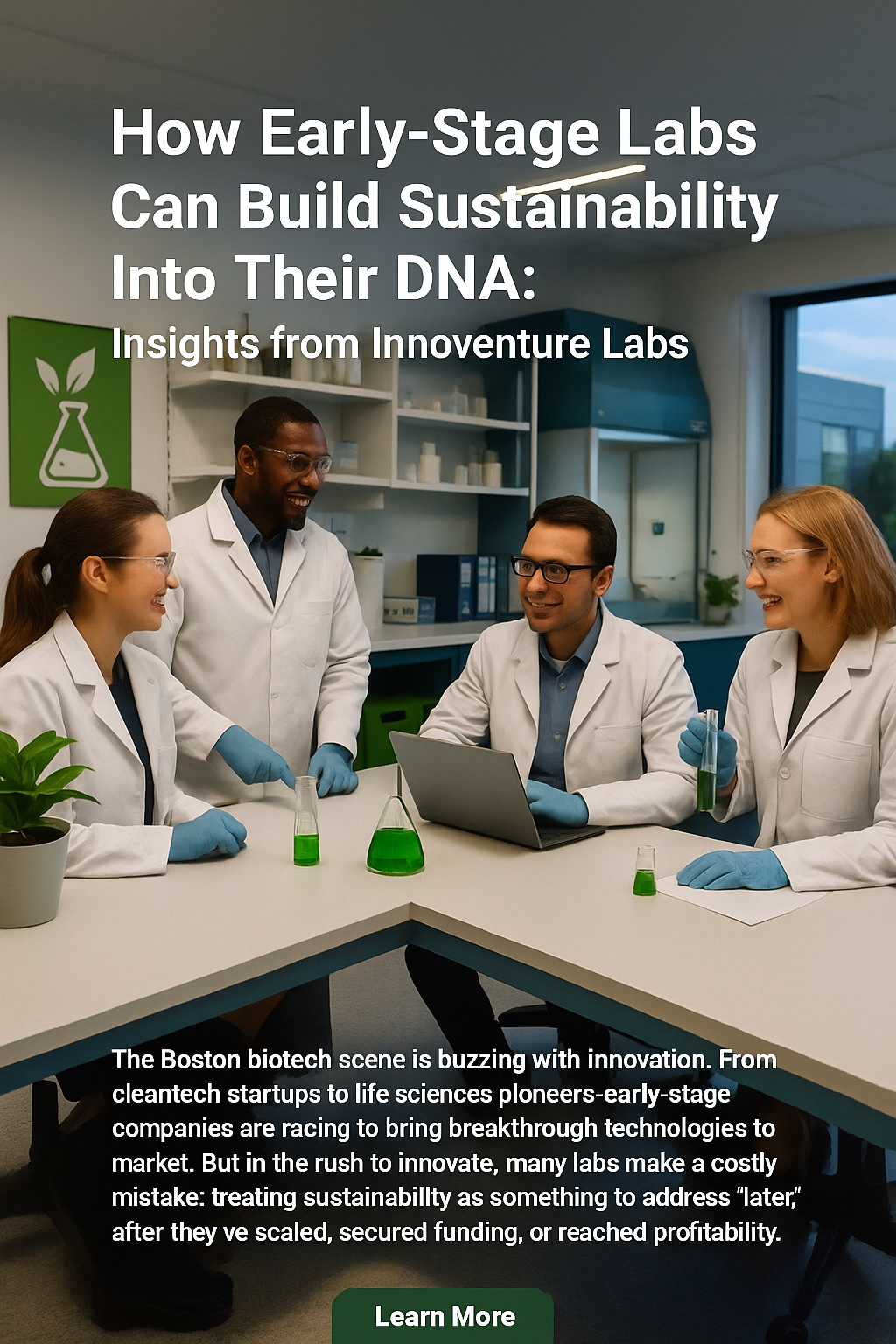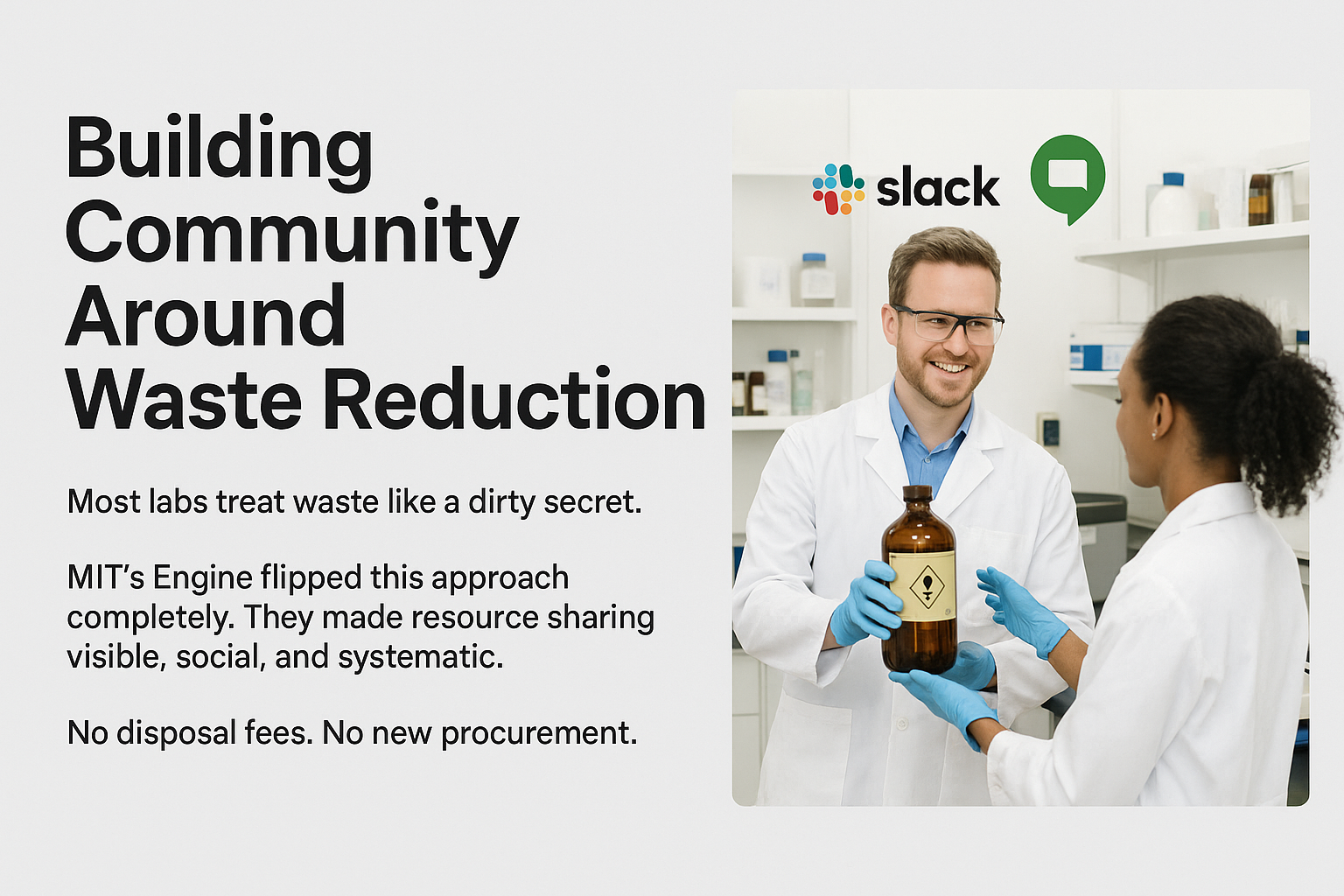How Early-Stage Labs Can Build Sustainability Into Their DNA: Insights from Innoventure Labs
How Early-Stage Labs Can Build Sustainability Into Their DNA: Insights from Innoventure Labs

A conversation with Amanda, Lab Operations Manager at Innoventure Labs, reveals why sustainability isn't just good ethics—it's good business.
The Boston biotech scene is buzzing with innovation. From cleantech startups to life sciences pioneers, early-stage companies are racing to bring breakthrough technologies to market. But in the rush to innovate, many labs make a costly mistake: treating sustainability as something to address "later," after they've scaled, secured funding, or reached profitability.
Amanda, Lab Operations Manager at Innoventure Labs, has seen this pattern countless times. Her message to startups? Sustainability shouldn't be an afterthought—it should be embedded from day one. And the labs that embrace this approach aren't just helping the planet; they're building more resilient, cost-effective operations.
In a recent conversation with LabRenew, Amanda shared insights from her unique career journey—from veterinary clinics to cannabis testing to managing a biotech incubator—and revealed practical strategies that any lab can implement immediately.
The Innovation Paradox: Balancing Speed with Responsibility
Innoventure Labs lives up to its name. As an incubator supporting biotech, cleantech, and life sciences startups, it's a place where innovation happens fast. But Amanda is clear about her priorities:
"Safety is number one for us. I want everybody to go home at the end of the day and see their family."
This safety-first mindset extends naturally to sustainability. Both require:
- Long-term thinking over short-term convenience
- Attention to detail and proper protocols
- Collective responsibility across the team
- Preventative measures rather than reactive fixes
But how do you balance the inherent messiness of R&D—with its trial and error, pivots, and failed experiments—with sustainable practices?
"It really is R&D, the research and development part, and so it's a lot of trial and error," Amanda acknowledges. "I sometimes see members get a little frustrated because things aren't working, because this is the innovation part of it, trying to invent, innovate new things."
The solution isn't to slow down innovation. It's to build infrastructure and provide mentorship that allows startups to focus on their science while sustainability is handled systematically.
The Shared Resource Model: Sustainability Through Collaboration
One of Innoventure Labs' most powerful sustainability strategies is deceptively simple: sharing.
"We offer turnkey facilities. So we have shared labs, lab suites, shared office spaces and individual office spaces," Amanda explains. This model means multiple startups share:
- Core equipment: Autoclaves, ultra-low temperature freezers, analytical instruments
- Lab infrastructure: Fume hoods, biosafety cabinets, specialized spaces
- Resources and expertise: Training, mentoring, troubleshooting support
The sustainability math is compelling. One shared autoclave serving ten companies eliminates the need for nine additional units—saving manufacturing resources, operational energy, maintenance, and eventual disposal impacts.
This collaborative approach extends to knowledge sharing. When one company discovers a more sustainable chemical alternative or optimizes a wasteful process, neighboring companies benefit. The learning curve shortens, and costly mistakes aren't repeated.
Lessons from Unexpected Places: Cross-Industry Sustainability
Amanda's diverse career background brings fresh perspectives to lab sustainability. Her veterinary clinic experience taught her lessons that directly translate to research labs.
The Reusables Principle
"Some of the things we would do is not use single item consumables," Amanda recalls. "For exam drapes, we would use towels and then wash them in energy efficient washers and dryers. We used metal instrumentation so that we could autoclave them."
The key insight: calculate the full lifecycle cost, not just the purchase price. Disposable plastic may seem cheaper upfront, but when you add disposal costs and repeat purchases, reusable alternatives often win—both economically and environmentally.
The Batching Strategy
"Fill the autoclave all at once and do a good run, so that we're not running and running and running the autoclave," Amanda advises.
This principle applies far beyond autoclaves:
- Batch your experiments to optimize material use
- Batch your orders to reduce shipping frequency and packaging waste
- Batch your waste disposal to maximize efficiency
- Coordinate with neighboring labs for shared deliveries
Preventative Maintenance Pays Dividends
"A lot of preventative maintenance that we emphasize definitely does reduce intervention and all of the resources that would be used later if there wasn't those prevention parts."
Well-maintained equipment:
- Runs more efficiently, using less energy
- Lasts longer, delaying replacement waste
- Prevents spills and accidents that create hazardous waste
- Performs more accurately, reducing failed experiments
From her cannabis testing days, Amanda learned another crucial lesson: optimize your waste streams. "I think a big one was optimizing our solvent waste. We had to use a lot of different chemicals, and doing batch samples, just pretty much optimizing things."
The Procurement Principle: Buy Smart, Not Big
Perhaps the most immediately actionable advice Amanda offers centers on procurement strategy.
"Only buy as much as you need. Obviously, have your backup for when you need it, but buying in smaller quantities definitely helps reduce things from expiring and then going into waste."
This is especially critical during the field testing phase. As Steve from LabRenew emphasizes: "When you're just field testing a new process, that is not the time to buy up, that is the time to buy very, very small."
The bulk-buying trap catches many startups:
- They receive a grant and want to be "prepared"
- They order large quantities to get volume discounts
- Months later, reagents expire unused
- They pay disposal fees for materials they paid to acquire
- They may need to reorder, doubling their costs
The smart approach:
- During R&D: Buy minimum quantities for 2-4 weeks of experiments
- During scale-up: Order based on validated consumption data, not estimates
- During production: Implement just-in-time inventory principles
"We guide to sustainable procurement methods, so that the businesses can really focus on the tech and what they're doing," Amanda explains. When procurement is optimized, scientists can focus on science.
The Economics of Sustainability: ROI That Goes Beyond Green
Steve from LabRenew challenges a persistent myth: that sustainability is expensive.
"Sustainability should be embedded in your everyday science. It really makes sense economically," he argues. "If you move towards green chemistry and do a full life cycle analysis, it may cost you a little bit more to use green chemicals, but your hazmat costs go way down."
The math is compelling:
Traditional Chemistry:
- Chemical cost: $100
- Hazmat disposal: $300-500
- Total: $400-600
Green Chemistry:
- Green chemical cost: $120
- Reduced disposal: $50-100
- Total: $170-220
The same logic applies to equipment. "If you buy efficient going out of the gate, you're in the best spot," Steve notes. Energy-efficient cold storage costs more upfront but saves significantly over its lifetime through lower operational costs.
This economic argument matters for startups operating on grants or seeking investment. "Fiduciary responsibility is important so you can work with your grant, or however you're getting your money, to make sure that you're spending it in the right way," Steve explains. "And sustainability inherently saves money in the long run."
Presenting sustainability as smart financial management—not just environmental stewardship—makes it easier to justify to investors and grant committees.
Building the Right Team: Diversity as Strategy
When asked for her top advice for early-stage labs, Amanda's answer surprised us:
"Have the right team to start working with, making sure that you have diverse people that can wear multiple hats. You don't need three or four people from the exact same school that do the exact same thing."
Why does team diversity matter for sustainability?
Different perspectives identify different solutions. Someone with a chemistry background might optimize solvents, while someone from engineering focuses on equipment efficiency, and someone from operations streamlines workflows.
Cross-pollination from adjacent fields. Amanda's own career illustrates this. Her veterinary experience taught her about reusables and preventative maintenance. Her cannabis testing background highlighted solvent optimization and digital systems. These diverse experiences now inform her approach to biotech sustainability.
Multiple hats means integrated thinking. When team members understand both the science and the operations, they make smarter decisions that balance innovation with sustainability.
The Support Infrastructure: You're Not Alone
One of the most important messages from our conversation came from Steve: "You're not alone. The sustainability community, especially where we are here, is very strong."
He's right. The Boston area (and beyond) offers incredible resources:
- I2SL (International Institute for Sustainable Laboratories): Technical expertise and best practices
- Bio: Industry advocacy and standards
- Sustainable Labs initiatives: Practical guidance and tools
- LabRenew: Hands-on support for lab optimization
- Incubators like Innoventure Labs: Embedded sustainability support
"There's very smart people like Amanda that are out there helping people, helping guide people through the process," Steve notes.
At Innoventure Labs, this support includes:
- Comprehensive safety training
- Equipment maintenance and optimization
- Procurement guidance
- Permitting and compliance support
- Emergency preparedness ("emergency showers, eye washes, spill kits, first aid kits, the whole nine yards")
The goal is simple: "So that the businesses can really focus on the tech and what they're doing."
Getting Started: Practical First Steps
Ready to embed sustainability in your lab? Here's where to start:
Week 1: Assess Your Current State
- Audit your chemical inventory (what's expired or near expiration?)
- Review your energy-consuming equipment
- Analyze your waste streams
- Calculate the dollar value of waste
Week 2: Identify Quick Wins
- Switch to reusables where appropriate
- Implement batch processing for autoclaves and waste
- Adjust procurement to smaller, more frequent orders
- Schedule preventative maintenance for all equipment
Week 3: Build Your Support Network
- Connect with your institution's sustainability office
- Reach out to neighboring labs for collaboration
- Contact organizations like LabRenew for guidance
- Join online communities and forums
Week 4: Establish Ongoing Systems
- Create monthly sustainability check-ins
- Designate a team member to coordinate efforts
- Track metrics (energy use, waste generation, costs)
- Celebrate and share successes
The Bottom Line: Sustainability as Competitive Advantage
The labs that will thrive in the coming years aren't the ones that delay sustainability until they can "afford" it. They're the ones that recognize sustainability as a competitive advantage - both environmentally and economically.
As Amanda demonstrates at Innoventure Labs, embedding sustainability from day one doesn't slow innovation. It enables it by:
- Reducing operational costs
- Minimizing regulatory risks
- Attracting sustainability-minded investors and talent
- Building resilient operations
- Focusing scientific energy where it matters most
"We try to help with mentoring, all the safety training we do, the permitting, making sure all of our emergency equipment is okay," Amanda summarizes. "And then we guide to sustainable procurement methods, so that the businesses can really focus on the tech and what they're doing."
That's the promise of embedded sustainability: not an additional burden, but a foundation that supports breakthrough science.
Start Your Sustainability Journey Today
Whether you're a solo researcher, a growing startup, or an established lab looking to optimize, the message is clear: you don't have to figure this out alone.
The sustainability community is ready to help. Organizations like LabRenew provide hands-on support. Incubators like Innoventure Labs offer infrastructure and mentorship. Professional networks connect you with peers solving similar challenges.
The question isn't whether you can afford to be sustainable. It's whether you can afford not to be.
.jpg)

